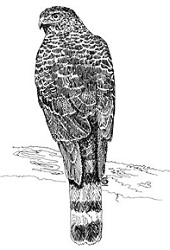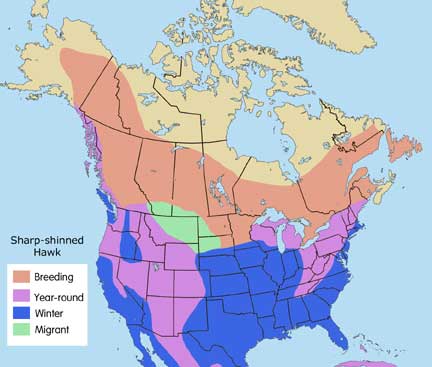
Scientific Name: Accipiter striatus
The smallest of the North American accipiters, or forest hawks, the sharp-shinned had a reputation of being the enemy of all small birds before research made it clear that it has no deleterious effect on the populations of its prey species. With its long slender body, short rounded wings and long narrow tail, this bird can twist and turn and dart through and around all the obstacles of a dense forest – or warehouse, or other buildings, where its penchant for chasing small birds can frequently lead it.
Males average less than 60% of the size (by weight) of females, making it the most extremely size dimorphic of the raptors. Immature birds are a dark grey-brown on the back, with brown vertical streaking on a cream colored breast; the eyes are yellow and large for its relatively small head. The adult becomes more grey on its back, and the front turns to horizontal rufous barring on a creamy breast; and the eyes turn red/orange. The beak seems small for a raptor, but the long legs and long skinny toes with relatively short talons are the quintessential bird-catcher’s feet; the tail has wide light bars alternating with narrow dark ones, and a squared off tip.
Male
Length: 9 – 10.50″
Wingspan: 21 – 22″
Weight: 3 – 4 oz.
Female
Length: 11 – 13.25″
Wingspan: 23 – 25″
Weight: 5 – 8 oz.
Protected under both state and federal laws; studied primarily on migration due to the difficulty of finding nest sites, the birds’ population status is difficult to determine.
Woodlands, though will hunt in the open. Frequent visitor at backyard bird feeders in pursuit of its primarily avian prey.
Almost exclusively small birds, from the size of creepers to woodpeckers as large or larger than itself; will also occasionally take small reptiles or amphibians, mammals, insects. Extreme difference in size between male and female thought to assist in resource allocation, to provide a wider range of prey species available to feed the young.
Typically silent most of the year; vocalizations between a pair during nesting season in dense forest may be the primary means of communication; the kek-kek-kek or kik-kik-kik alarm call is higher, thinner and faster than Cooper’s hawk. Other calls may be given by male as he arrives at nest with food, by begging juveniles, or in flight by hunting juveniles; the call note is a plaintive whine.
Very difficult to study, as nests are well hidden; nests are built of sticks, twigs and lined with strips of bark, up to 2′ across, usually in the crotch or between a branch and the trunk of a tree, usually a dense conifer. Breeding typically timed to coincide with fledging of their songbird prey.
Flying into windows, getting trapped in buildings, tangling in fencing and netting, being hit by cars.

Found throughout North America, including Mexico, into Central America and the Caribbean, the sharpie is a shy and secretive bird of both urban and rural woodlands.
Special Thanks for range maps:
Dan Gleason
BGleason Design & Illustration
Commercial & Scientific Illustration, Graphic Design
CraneDance Communications
Book Production/Design

